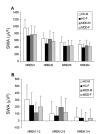Sex Differences in Slow-wave Electroencephalographic Activity (SWA) in Adolescent Depression
- PMID: 25478107
- PMCID: PMC4253368
- DOI: 10.4081/mi.2012.e4
Sex Differences in Slow-wave Electroencephalographic Activity (SWA) in Adolescent Depression
Abstract
Sleep disturbances, present in more than 90% of major depressive disorder (MDD) patients, are moderated by sex in adult MDD. In particular, slow-wave electroencephalographic activity (SWA; 0.5-4 Hz) accumulation is low and dissipation impaired. This SWA abnormality in depressed adult males does not change with age, suggesting that SWA abnormality appears at early ages. The present study evaluated sex differences in SWA in adolescents with MDD compared to healthy controls. We evaluated regularized sleep-wake schedules at home for 5-7 days, followed by two consecutive nights of sleep EEG recording. The study included 104 participants, 52 symptomatic and depressed subjects (MDD: 20 males and 32 females) and 52 healthy controls (HC: 20 males and 32 females), aged 13-18 years. SWA power and dissipation, and duration and latencies to each Non-Rapid Eye Movement (NREM) sleep period were calculated for each group. Results showed that SWA accumulation in the first NREM period was lower and its dissipation across the night more irregular in MDD males compared to HC males (P<0.009). By contrast, SWA was equivalent in MDD and HC females. In conclusion, as reported in adult MDD, the accumulation and dissipation of SWA was abnormal in depressed adolescents, but only in males. SWA abnormalities in adolescent MDD may relate to different depressive symptoms in females and males. These results underscore the need to develop sex-specific therapies to enhance and restore SWA in depressed adolescents.
Keywords: adolescence; depression; sex differences; sleep.
Conflict of interest statement
Conflict of interest: RA is a paid consultant for Eisai Inc.; however, her activities are unrelated to the present work. GE receives research support from Biobehavioral Diagnostics Inc., Eli Lilly, Forest Laboratories, GlaxoSmithKline, and Somerset, is a consultant for Biobehavioral Diagnostics Inc., Eli Lilly, Forest Laboratories, GlaxoSmithKline, INC Research Inc., Lundbeck, Pfizer Inc., Shire Pharmaceuticals, Validus Pharmaceuticals, and Wyeth Pharmaceticals, and is on the Speakers Bureau for Forest Laboratories, Inc.; however, these activities are unrelated to the present work. JL and RH have no conflict of interest to report.
Figures
Similar articles
-
Sleep and slow-wave activity in depressed adolescent boys: a preliminary study.Sleep Med. 2017 Oct;38:24-30. doi: 10.1016/j.sleep.2017.06.029. Epub 2017 Jul 25. Sleep Med. 2017. PMID: 29031752
-
Sleep homeostasis in alcohol-dependent, depressed and healthy control men.Eur Arch Psychiatry Clin Neurosci. 2011 Dec;261(8):559-66. doi: 10.1007/s00406-011-0195-5. Epub 2011 Feb 11. Eur Arch Psychiatry Clin Neurosci. 2011. PMID: 21312040 Free PMC article.
-
Slow-wave activity in NREM sleep: sex and age effects in depressed outpatients and healthy controls.Psychiatry Res. 2000 Sep 11;95(3):201-13. doi: 10.1016/s0165-1781(00)00178-5. Psychiatry Res. 2000. PMID: 10974359
-
Slow wave activity during sleep: functional and therapeutic implications.Neuroscientist. 2010 Dec;16(6):618-33. doi: 10.1177/1073858410377064. Epub 2010 Oct 4. Neuroscientist. 2010. PMID: 20921564 Review.
-
The visual scoring of sleep and arousal in infants and children.J Clin Sleep Med. 2007 Mar 15;3(2):201-40. J Clin Sleep Med. 2007. PMID: 17557427 Review.
Cited by
-
Exploring the link between waking gamma and sleep delta power in healthy volunteers and individuals with treatment-resistant depression.J Affect Disord. 2025 Sep 15;385:119448. doi: 10.1016/j.jad.2025.119448. Epub 2025 May 19. J Affect Disord. 2025. PMID: 40398609 Clinical Trial.
-
Sleep Delta power, age, and sex effects in treatment-resistant depression.J Psychiatr Res. 2024 Jun;174:332-339. doi: 10.1016/j.jpsychires.2024.04.028. Epub 2024 Apr 17. J Psychiatr Res. 2024. PMID: 38697012 Free PMC article.
-
Increased frontal sleep slow wave activity in adolescents with major depression.Neuroimage Clin. 2015 Nov 10;10:250-6. doi: 10.1016/j.nicl.2015.10.014. eCollection 2016. Neuroimage Clin. 2015. PMID: 26870661 Free PMC article.
-
Age-Related Differences in Sleep Architecture and Electroencephalogram in Adolescents in the National Consortium on Alcohol and Neurodevelopment in Adolescence Sample.Sleep. 2016 Jul 1;39(7):1429-39. doi: 10.5665/sleep.5978. Sleep. 2016. PMID: 27253763 Free PMC article.
-
Evidence of a maturational disruption in non-rapid eye movement sleep slow wave activity in youth with attention-deficit/hyperactivity, learning and internalizing disorders.Sleep Med. 2022 Feb;90:230-237. doi: 10.1016/j.sleep.2022.01.026. Epub 2022 Feb 8. Sleep Med. 2022. PMID: 35217303 Free PMC article.
References
-
- Zisook S, Rush AJ, Albala A, et al. Factors that differentiate early vs. later onset of major depression disorder. Psychiatry Res 2004;129:127-40. - PubMed
-
- Kovacs M, Feinberg TL, Crouse-Novak MA, et al. Depressive disorders in childhood. I. A longitudinal prospective study of characteristics and recovery. Arch Gen Psychiatry 1984;41:229-37. - PubMed
-
- Rao U, Ryan ND, Birmaher B, et al. Unipolar depression in adolescents: clinical outcome in adulthood. J Am Acad Child Adolesc Psychiatry 1995;34:566-78. - PubMed
-
- Weissman MM, Bland RC, Canino GJ, et al. Prevalence of suicide ideation and suicide attempts in nine countries. Psychol Med 1999;29:9-17. - PubMed
-
- Birmaher B, Ryan ND, Williamson DE, et al. Childhood and adolescent depression: a review of the past 10 years. Part II. J Am Acad Child Adolesc Psychiatry 1996;35:1575-83. - PubMed
Grants and funding
LinkOut - more resources
Full Text Sources

